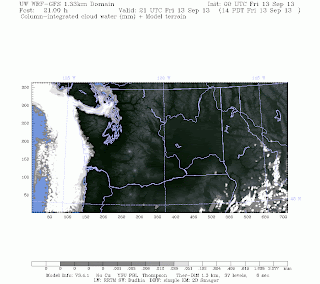What is the most difficult forecast for a Northwest meteorologist?
(a) Big windstorm from an approaching Pacific cyclone?
(b) Strong winds in the Strait of Juan de Fuca?
(c) Downslope winds in Enumclaw?
(d) Predicting fog/stratus burn out over Puget Sound during the fall?
The correct answer is d. And today was a sobering example of a bad forecast. And I will tell you why.
We woke up this morning with low clouds over western Washington (see image).
One sign that the cloud deck was relatively thick was that clouds extended deeply into the Cascade valleys. Another sign was that there was light drizzle at a number of locations.
The official National Weather Service forecast even at 9 AM this morning was for a burn off of the low clouds during the afternoon..
NATIONAL WEATHER SERVICE SEATTLE WA 900 AM PDT FRI SEP 13 2013 .SYNOPSIS...MARINE CLOUDS OVER WESTERN WASHINGTON WILL BURN OFF DURING THE AFTERNOON.
This was not an unreasonable forecast for mid-September: the sun is still fairly strong, and our numerical models indicated a burn out during the late morning. I also thought we would see some sun in the afternoon for the same reasons....we were both wrong.
Take a look at the visible satellite picture for 5 PM. The clouds did burn off over Portland and Willamette Valley, over Bellingham, and Victoria. The clouds pulled back from the Cascades...but Puget Sound was still socked in. Not good.
The high-resolution UW WRF forecast had the clouds right at 8AM
But the 2 PM forecast the clouds wer nearly gone over Puget Sound.
And my favorite National Weather Service High Resolution Rapid Refresh (HRRR) Model had virtually no clouds at 2 PM, based on a 6-hr forecast. Disappointing.
So what went wrong? This situation exposes one of the classic problems of our current modeling systems: they tend towards excessive mixing in the lowest layers under stable conditions, and such excessive mixing can destroy shallow fog and stratus layers. Human forecasts know about this tendency, but clearly our ability to subjectively correct the forecasts is not perfect.
The observed temperature soundings at Seattle (NOAA Sand Point) showed a deep cool layer (where the clouds were), topped by an inversion with a base at around 600 meters above sea level. (graphic shows temps for 8am (15 UTC) to 2 PM (21 UTC).
The model sounding (red temperature, blue dewpoint) was not bad at 8 AM (15 UTC): the air was saturated low down (blue and red lines on top of each other) and the model had an inversion above.
But by 18 UTC (11 AM) the model forecast was way wrong with the saturation gone (no clouds) and the inversion way too weak.
At 21 UTC (2 PM), we were in disaster land. The model inversion pretty much gone in the model. The lower layer got even drier.
Anyway, this kind of behavior is not unusual and it reflects a basic model weakness. For the technically minded, this is probably a deficiency in our boundary layer parameterization schemes.
When I biked to work in light drizzle I knew my earlier forecast of an afternoon break out was in trouble.
This profession keeps one humble.
Home
»
»Unlabelled
» Low Cloud Forecast Failure
Thứ Sáu, 13 tháng 9, 2013
Đăng ký:
Đăng Nhận xét (Atom)
Bài đăng phổ biến
-
Koharu Nishino is a japanese gravure idol born in Saitama on 5 7 1989. Her blood type is B, and she is 155 cm tall, Koharu's body measur...
-
Kana Ito is a japanese gravure idol born in Fukuoka on 28 7 1984. Her blood type is A, and she is 161 cm tall, Kana's body measurements ...
-
Profile Elly Tran Ha Real Name : Tran Kim Hong Date of Birth: 6/8/1987 Height: 168 cm Measurements: 88-58-90 cm Place of Birth: Viet Nam Na...
-
This morning I didn't plan on biking home in strong winds, rumbling thunder, light rain and a blocked bike trail....but it happened. Du...
-
Five Vi Rahmawati Profile: Name: Five Vi Rahmawati Birthday:December 12, 1979 Gender: Female Religion: Islam Born: Surabaya Five Vi Rahmawa...
-
The media mentions it frequently and global warming skeptics talk of little else: the fact that global atmospheric temperatures have not go...
-
Tsubasa Nagumo is a japanese gravure idol born in Kanagawa on 10 3 1988. Her blood type is O, and she is 160 cm tall, Tsubasa's body mea...
-
Kana Ito is a japanese gravure idol born in Fukuoka on 28 7 1984. Her blood type is A, and she is 161 cm tall, Kana's body measurements ...
-
Here is an amazing picture sent to me by Bill Anderson showing the shadow from an aircraft contrail on a lower cirrostratus cloud deck. The...
-
Cô giáo Thảo-Mai Nishida tại trường học Mai Nishida khiêu dâm tại trường





















0 nhận xét:
Đăng nhận xét